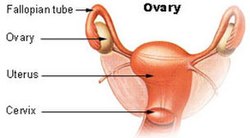Female genitalia
Female reproductive system (Organa genitalia feminina)[edit | edit source]
- enables sexual connection
- ensures the development of a new individual
- ensures the formation of sex cells, eggs and sex hormones
- the ovary is the gonad → connects to the fallopian tube → uterus → vagina
Internal genital organs[edit | edit source]
Ovary (Ovary)[edit | edit source]
The Ovary is a paired organ about the size of a plum, found nestled against the lateral walls of the small pelvis suspended from the back of the broad ligament of the uterus. The appearance and size of the ovary changes with age - in youth its surface is smooth, after the onset of the menstrual cycle we can observe a gradually furrowed appearance (small scars after the release of eggs)
The ovary has two layers - the medulla (nutrition of the ovaries, contains nerve fibers vegetative system) and the cortical (it contains the female sex cells). Each sex cell is surrounded by a layer of epithelial cells, in which a Graafian follicle is formed (production of sex hormones)
Oviduct (Tuba Uterina)[edit | edit source]
Oviduct is approximately 13 cm long, funnel-shaped. Its beginning is freely open to the abdominal cavity. The movement of the eggs is caused by the fringes that are placed on the surface of the fallopian tube during ovulation. The other end of this female organ opens into the uterus at the uterine horns. The inner surface is lined with a mucous membrane with cilia, under the mucous membrane there is smooth muscle. The ovaries and fallopian tubes are collectively called appendages "uterine adnexa".
Womb (Uterus)[edit | edit source]
The Uterus is an unpaired, pear-shaped organ located between the Urinary Bladder and the Anus. It is divided into "cervix uteri" and "corpus uteri". The fallopian tubes open into the uterine horns, between which the uterine floor arches. The uterine cavity is narrow in non-pregnant women - the front and back walls press against each other. During pregnancy, the uterus enlarges several times, and at the end of pregnancy, the uterine fundus reaches the diaphragm. Physiologically, the uterus is bent forward and at the same time tilted forward (AVF - anteflexe, anteversion). The mucous membrane of the body has two layers:
- pars functionalis - undergoes changes during the reproductive period under the influence of hormones from the ovary - menstrual cycle
- pars basalis - restoration of the mucosa if fertilization does not occur
Sheath (Vagina)[edit | edit source]
The vaginal mucosa is made up of squamous epithelium. There are bacteria that ferment glucose to lactic acid → acidic environment → protection against inflammation. In virgins, a mucous membrane (hymen) - hymen - with an opening allowing the outflow of menstrual blood.
External genital organs[edit | edit source]
Mound of Venus (Mons pubis)[edit | edit source]
It is a fat pad in front of the pubic clasp. The skin above it is covered with hair.
Labia majora[edit | edit source]
The labia majora are formed by elongated skin mounds filled with fatty tissue. They contain a spongy vein plexus. The outer side is covered with hairs.
Labia minora[edit | edit source]
Flat internal mucosal cilia (formed by mucous membrane) surrounding the vaginal vestibule.
Vestibular glands[edit | edit source]
The vestibular glands are located under the mucous membrane of the vaginal entrance. The largest is a pair of pea-sized Bartholin's glands that drain onto the underside of the labia minora.
Topical tissues[edit | edit source]
- clitoris (=cup) - unpaired. Stored above the mouth of the urethra. Its structure corresponds to the erector spinae of the penis.
- bulbi vestibuli - paired. Located around the ostium vaginae and ostium urethrae externum cranial to the paired Bartholin's gland below the labia minora.


